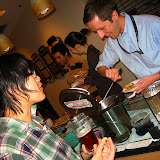
According to SlowFood USA, food is a common language. We all share the same fundamental nutritional needs and the pleasure of the meal is not bound by time, place, or culture. Also like language, however, food can be mutated, manipulated and adapted. In her book
The Jungle Effect Dr. Daphne Miller, M.D. traverses the globe and traces time to unearth several original, indigenous diets that have gotten lost in translation through the westernization of the world’s food system.
Through a bifocal lense – part clinical, part anthropological – Miller examines the traditional diets of 5 “cold spots”. These are places tucked away in far-flung pockets of the world where native diets remain largely isolated from American influence, and, not surprisingly, nearly free of the chronic diseases that typify western health. Her stories read more like travel writing than tired diet book, and she takes you with her as she hopscotches across continents and explores their native foodscapes.
First, in
Copper Canyon, Mexico, a cold spot for type 2 diabetes, Miller observes the dietary practices of the
Tarahumara Indians. While long-distance running is a trademark of their culture and undoubtedly plays a role in their preserved insulin sensitivity, Miller discovers that the Tarahumara also benefit from key indigenous ingredients. These are mainly three slow-release carbohydrate staples: heirloom maize, beans, and squash. Other antidiabetic ingredients indigenous to the area include
nopales (cactus),
jicama (aka “Mexican turnip”), and indigenous herbs and spices (like cinnamon, cloves, and fenugreek seeds).
In
Crete, Miller sets off in search of the “real” Mediterranean diet and the secret to staving off heart disease. In addition to pointing out the standard Mediterranean signposts, like olive oil and wine, she also goes hunting for horta (wild greens) in the Cretan hillsides and introduces you to local cheeses (used in moderation) like
anthotyoros and
kefalotyri.
Then it’s off to
Iceland, where rates of depression are astonishingly low. Since Icelanders’ resistance to depression cannot be attributed to any genetic predisposition, and it’s certainly not on account of the weather (think permafrost and endlessly dark winters), Miller arrived in Reykjavik to find the food-mood link. The answer, she discovered, lies mostly in omega-3 fatty acids – not just in the fish (though they do eat lots and lots of the stuff), but in their wild game, cheese,
skyr (Icelandic yogurt), and milk. Turns out, the grass, clover, and moss on which their animals graze (free range!) is also an incredibly rich source of ALA. Between fish, meat, and milk, the average Icelander gets a healthy dose of depression-fighting omega-3’s at nearly every meal.
On her next excursion she takes you to
Cameroon, a cold spot for bowel trouble. From colon cancer to acid reflux, Cameroonians have particularly healthy GI plumbing. After her time in Ntui, a small village in the rainforest of central Cameroon, Miller found that the benefits their indigenous foods can be summarized by the five F’s. First, fiber is a mainstay in the Cameroonian diet with starch staples like
millet,
sorghum,
teff, local hybrids of maize, plaintain, and brown rice. Second, Cameroonians eat less flesh. A low-meat diet may be just as important in preventing colon cancer as a high-fiber one. The diet is also high in fermented foods and foraged (and folate-rich) greens and select fats. Interestingly, there may be an anticancer effect from both unrefined peanut oil and palm fruit oils, high in PUFAs and antioxidant beta-sitosterol. Palm fruit oil is also high in antioxidant vitamins A and E.
Her final trip is to
Okinawa, where there are notably few cases of, among other diseases, breast and prostate cancers. While soy is an Okinawan staple, the proverbial jury remains undecided on soy’s role in breast and prostate health. However, one school of thought suggests that soy in its natural form, such as tofu,
miso,
edamame, and soy milk, may have protective effects; processed soy, like that found in soy protein powders, texturized vegetable protein, and energy bars may be detrimental. All soy aside, however, Okinawans small portion sizes, lean BMI’s and plant-based diet add significant pieces to the cancer puzzle. Antioxidant-rich Okinawan fruits and vegetables linked to breast and prostate cancer prevention include garlic, onions, and leeks, cruciferous vegetables, goya (
bitter melon), tomatoes, watermelon, grapefruit, guava, imos (yams), and green tea. Active ingredients in their maitake, reishi, and shiitake mushrooms may also play a role in cancer prevention.
Miller asserts that you do not have to live in the outermost cultural edges to reap the benefits of an indigenous diet. Throughout her journeys from place to place and plate to plate, she discovers that common denominators are clear and can universally translatable (and oh-so aligned with the SlowFood mentality):
1. Choose foods that are fresh, local, and in season.
2. Learn, practice, and appreciate food cultivation techniques and recipes passed down through the ages.
3. Preserve endangered food traditions like communal eating, eating for satiety rather than fullness, and observing fasts and other food rituals.
4. Limit sugar to that found naturally in foods like honey, fruits, vegetables, and whole grains
5. Get salt from natural, unprocessed sources such as fish, sea greens, and vegetables.
6. Eat meat in small quantities in favor of plant-based protein.
7. Select nonmeat fats from whole nuts, seeds, grains, and fatty fruits and minimally processed oils such as olive, palm fruit, or coconut oil.









 cheese cave in New England (theirs!) and their aging process. The store has
cheese cave in New England (theirs!) and their aging process. The store has 




